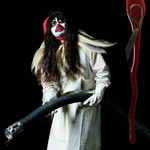Drawing Restraint 9
Studio Album by Bjork released in 2005Gratitude | |
Pearl | |
Ambergris March | |
Bath | |
Hunter Vessel | |
Shimenawa | |
Vessel Shimenawa | |
Storm | |
Holographic Entrypoint | |
Cetacea | |
Antarctic Return |
Drawing Restraint 9 review
Who better to compose a soundtrack for acclaimed contemporary visual artist Matthew Barney than the mind-boggling musical Icelandic wonder they call Bjork? Drawing Restraint 9 finds the kooky girl at her most experimental (when isn't she?), stripping down her usual multiple layers of music to concentrate on one solitary instrument (sometimes a harp, a celeste or a harpsichord). Barney's latest work, the two hour and fifteen minute magnum opus Drawing Restraint 9, was shot in Nagasaki Bay on board the Japanese whaling ship Nisshin Maru. Its core idea is the relationship between self-imposed resistance and creativity. Barney and Bjork are a perfect coupling: his unsettling phantasmagorias and her erotic meditations on love that chafe against the strictures of what constitutes a song. Refusing to choose between pop pleasure and restless experimentation, Bjork's musical vision weds technology and emotion, countering gut-level expression with an insistence upon formal modernity and innovation.
This intense soundtrack sees Bjork pick up the Japanese threads of Barney's film, writing music for the sho (a Japanese instrument with 17 reeds and 15 pipes) and incorporating Noh theatre in the vocals for Holographic Entrypoint. As challenging a work as any Bjork has produced, Drawing Restraint 9 is not easy listening. Set on a Japanese whaling ship, Bjork's soundtrack is a murky mood piece featuring icy string sprays, sonar blips, and Bjork's distressed, often whale-like vocals. The nearest thing to a conventional song is opener Gratitude, in which on whaling over shimmers of harp and celeste Will Oldham sings the words of a letter written to General MacArthur imploring him to allow whaling to resume off Japan after the war.
Though her melodic gifts and ambitious arrangements have often led her to create songs with a cinematic quality to them (consider the John Barry-esque drama of Bachelorette), the most obvious initial reference point when considering Bjork as a composer for the screen would be Selmasongs, her soundtrack for Lars von Trier's film Dancer In the Dark, in which she also starred. But where that album was anchored in its titular character and in musical theatre as a founding genre, here Bjork's compositions must respond to the polyvalent world of Barney's artwork, in which an abstracted narrative is only implied. Fittingly, Bjork's soundtrack primarily orients itself around the traditional musical forms of Japan. Effortlessly sidestepping any attempt at cheap pastiche or ethno-fusion cliches, Bjork has instead written a suite of haunting new music for one of the culture's oldest instruments, the sho.
Bjork's soundtrack for Drawing Restraint 9 shows a refreshingly open-hearted capacity to take Japanese history and culture both seriously and creatively, forging a poetics of translation which is as thoughtful as it is insistently new. Typically eccentric and irresistibly seductive this release is intimate, beautiful and powerful. This is a must have for any Bjork fans and is an album which, if not a soundtrack, could without question stand happily alongside her other albums as yet another great musical release from Icelandic genius Bjork.

